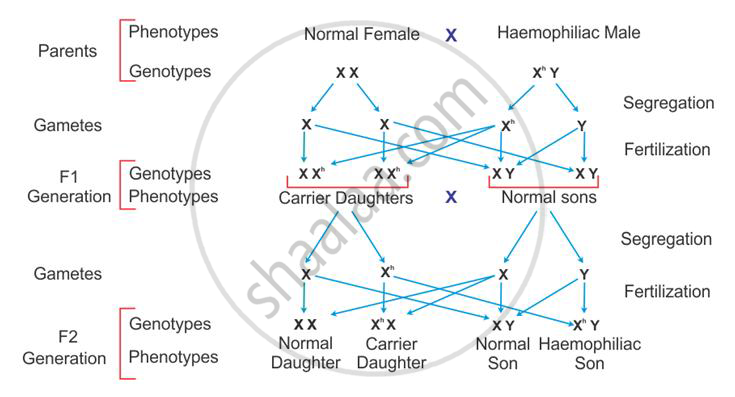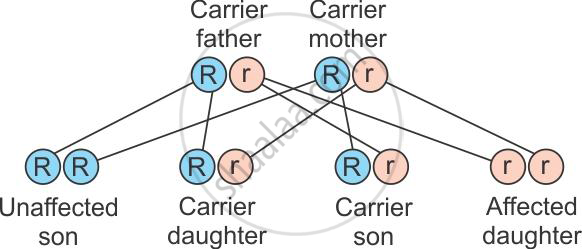Advertisements
Advertisements
प्रश्न
(a) Why are thalassemia and haemophilia categorized as Mendelian disorders? Write the symptoms of these diseases. Explain their pattern of inheritance in humans.
(b) Write the genotypes of the normal parents producing a haemophilic son.
उत्तर
(a) Thalassaemia and haemophilia are categorised as Mendelian disorders because these are determined by alternation or mutation in a single gene.
Symptoms of thalassaemia: The main symptoms of thalassaemia are anaemia, jaundice, hepatosplenomegaly, cardiac enlargement and skeletal deformities.
Symptoms of haemophilia: Haemophilia is also called bleeder’s disease in which a single cut leads to non-stop bleeding. It prevents clotting of blood. A seriously affected person may bleed to death after even a minor skin cut.
Inheritance pattern of haemophilia:
This is a sex-linked recessive disease which shows its transmission from an unaffected carrier female to some of the male progeny. It shows criss-cross inheritance. The heterozygous female (carrier) for haemophilia may transmit the disease to sons. The possibility of a female becoming a haemophilic is extremely rare because the mother of such a female would have to be at least a carrier and the father should be haemophilic.

Inheritance pattern of thalassaemia:
Thalassaemia is an autosomal, recessively inherited blood disorder transmitted to the offspring when both parents are heterozygous. The defect arises because of either mutation or deletion which results in the reduced rate of synthesis of one of the globin chains of haemoglobin.

APPEARS IN
संबंधित प्रश्न
Give the importance of heterocyst in cyanobateria.
Mention the symptoms of Phenylketonuria.
Identify the option that correctly represents the number of chromosomes in Down syndrome.
If a colour-blind man marries a woman who is homozygous for normal colour vision, the probability of their son being colour-blind is ______.
Mental retardation in man associated with sex chromosomal abnormality is usually due to ______.
Down’s syndrome is due to ______.
If both parents are carriers for thalassaemia, which is an autosomal recessive disorder, what are the chances of pregnancy resulting in an affected child?
Placed below is a karyotype of a human being.

On the basis of this karyotype, which of the following conclusions can be drawn: ______
It is said, that the harmful alleles get eliminated from population over a period of time, yet sickle cell anaemia is persisting in human population. Why?
Mention any one symptom of Turner's syndrome.
